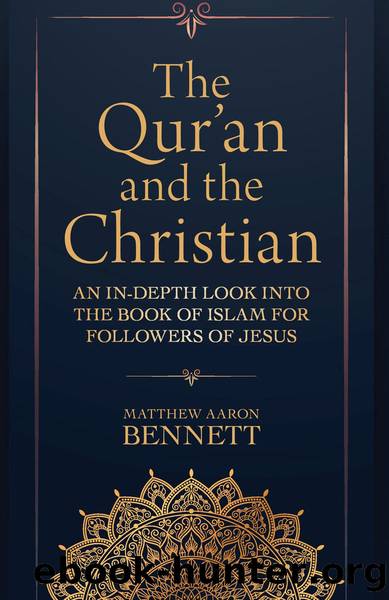The Qur'an and the Christian by Matthew Aaron Bennett

Author:Matthew Aaron Bennett
Language: eng
Format: epub
Publisher: Kregel Academic
Published: 2022-01-15T00:00:00+00:00
1 Gabriel Said Reynolds, The Qurâan and Its Biblical Subtext (New York: Routledge, 2010), 33.
2 Reynolds, The Qurâan and its Biblical Subtext, 35. Reynolds writes, â[Muhammadâs biography] goes to great lengths to emphasize Muhammadâs pagan context. Thereby it emphasizes the divine origin of the Qurâan, by having Muhammad far away from the traditional centers of Judaism and Christianity, in a city that was the last, proud metropolis of paganism.â
3 For investigations into the Qurâanâs original audience from an orientalist perspective, see John Wansborough, The Sectarian Milieu: Content and Composition of Islamic Salvation History (Amherst, NY: Promethius, 2006). Also, W. Montgomery Watt and Richard Bell, Bellâs Introduction to the Qurâan (Edinburgh: Edinburgh University Press, 1970). From a confessional perspective, see Muhammad Mustafa al-âAzami, The History of the Qurâanic Text: From Revelation to Compilation (Lahore, Pakistan: Suhail Academy Press, 2005).
4 The Arabic phrase, ahl al-kitab, appears in multiple places throughout the Qurâan to designate the Jews and Christians who have received books of divine revelation. Ex. Qurâan 2:105; 3:64â65; 4:123; 29:46; 57:29.
5 Interestingly Qurâan 5:69 is nearly identical to Qurâan 2:62. Likewise, Qurâan 22:17 presents similar phrasing, though with the notable addition of the Qurâanâs singular reference to the Magians/Zoroastrians who appear to be related to the Magi of Matthew 2:1, 7, 16. See A. J. Droge, The Qurâan: A New Annotated Translation (Bristol, CT: Equinox, 2015), 215n30.
6 See Sidney Griffith, âAl-Nasara in the Qurâan,â in New Perspectives on the Qurâan: The Qurâan in Its Historical Context 2, ed. Gabriel Said Reynolds, 301â22 (New York: Routledge, 2011), 301.
7 Cf. Qurâan 2:87: âCertainly We gave Moses the Book, and followed up after him with the messengers.â
8 Cf. Qurâan 5:12â14, in which mithaq is used to describe a covenant or pledge taken by both the Israelites and the Christians, thus acknowledging the presence of covenant in both groups.
9 Mark Durie, The Qurâan and Its Biblical Reflexes (New York: Lexington, 2018), 195â213. Durie convincingly demonstrates the conceptual difference between biblical covenants and the qurâanic âahid and mithaq.
10 Cf. Qurâan 8:55â56, which says, âSurely the worst of creatures in the sight of God are those who disbelieveâand they will not believeâthose of them with whom you have made a treaty, (and) then they break their treaty every time, and they do not guard (themselves).â
11 Gerhard Von Rad, Genesis, rev. ed. (Philadelphia: Westminster, 1972), 188.
12 See Alistair Wilson and Jamie Grant, âIntroduction,â in The God of Covenant, ed. Alistair Wilson and Jamie Grant (Leicester, UK: Apollos, 2005), 12, who write, âCovenant is all about relationship between the Creator and his creation.â
13 Mark Durie, The Qurâan and Its Biblical Reflexes (New York: Lexington, 2018), 212â13.
14 To the point of the covenants completed in Christ, see the monumental work by Peter Gentry and Stephen Wellum, Kingdom through Covenant (Wheaton, IL: Crossway, 2012), 22â25.
15 Israelâs rejection in the Qurâan is clearly stated in Qurâan 5:13, which states, âFor their breaking their covenant, We cursed them and made their hearts hardâ¦. You will continue to see treachery from them, except for a few of them.
Download
This site does not store any files on its server. We only index and link to content provided by other sites. Please contact the content providers to delete copyright contents if any and email us, we'll remove relevant links or contents immediately.
| Hadith | History |
| Law | Mecca |
| Muhammed | Quran |
| Rituals & Practice | Shi'ism |
| Sufism | Sunnism |
| Theology | Women in Islam |
The History of Jihad: From Muhammad to ISIS by Spencer Robert(2216)
Nine Parts of Desire by Geraldine Brooks(2014)
The Turkish Psychedelic Explosion by Daniel Spicer(2000)
The First Muslim The Story of Muhammad by Lesley Hazleton(1891)
The Essential Rumi by Coleman Barks(1641)
The Last Mughal by William Dalrymple(1575)
Trickster Travels: A Sixteenth-Century Muslim Between Worlds by Davis Natalie Zemon(1547)
1453 by Roger Crowley(1511)
by Christianity & Islam(1354)
God by Aslan Reza(1339)
Muhammad: His Life Based on the Earliest Sources by Martin Lings(1309)
A Concise History of Sunnis and Shi'is by John McHugo(1279)
Magic and Divination in Early Islam by Emilie Savage-Smith;(1205)
The Flight of the Intellectuals by Berman Paul(1187)
No God But God by Reza Aslan(1166)
Art of Betrayal by Gordon Corera(1136)
What the Qur'an Meant by Garry Wills(1124)
Getting Jesus Right: How Muslims Get Jesus and Islam Wrong by James A Beverley & Craig A Evans(1083)
The Third Choice: Islam, Dhimmitude and Freedom by Durie Mark & Ye'or Bat & Bat Ye'or(1071)
